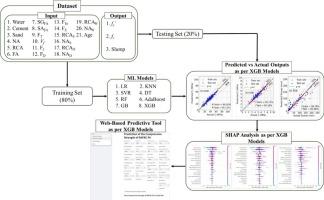利用可解释的极端梯度增强机器学习模型和预测工具研究再生骨料纤维增强粉煤灰混凝土的抗压强度、抗弯强度和坍落度
IF 4.6
2区 工程技术
Q2 ENGINEERING, CHEMICAL
引用次数: 0
摘要
本研究开发了机器学习预测模型来评估再生骨料纤维增强粉煤灰混凝土(RAFRC-FA)的抗压强度(f'c)、抗折强度(fr)和坍落度。这些模型是使用一个数据库开发的,该数据库分别编译了1028、531和430条关于f'c、fr和坍落度的记录,其中21个输入参数与混凝土成分、粉煤灰、纤维和混凝土测试年龄(对于f'c和fr)相关。本研究共采用了代表单一和集成算法的8个机器学习模型。结果表明,极端梯度增强(XGB)模型的平均绝对误差为2.10 MPa和95.11%,斜率为0.26 MPa和92.16%,坍落度为15.54 mm和85.98%,优于所有模型。此外,与传统分析模型相比,XGB模型的预测-实际比标准差(0.024和0.042)和方差系数(2.36%和4.20%)分别最低。此外,SHapley添加剂解释(SHAP)工具表明,混凝土成分是影响RAFRC-FA抗压和抗弯强度的最大因素,而骨料性能对RAFRC-FA坍落度的影响最大。此外,开发了一个基于网络的应用程序,并使用未见过的数据进行验证,用于预测RAFRC-FA的力学性能。基于web的应用程序对f'c、fr和坍落度的预测的实验与预测之比分别在1.00 ~ 1.13、0.99 ~ 1.06和1.00 ~ 1.13之间。本文章由计算机程序翻译,如有差异,请以英文原文为准。

Compressive strength, flexural strength, and slump of recycled aggregate fibre-reinforced fly ash concrete using explainable extreme gradient boosting machine learning model with prediction tool
This study develops machine learning predictive models to evaluate the compressive strength (f'c), flexural tensile strength (fr), and slump of recycled aggregate fibre-reinforced fly ash concrete (RAFRC-FA). The models were developed using a database compiling 1028, 531, and 430 records for f'c, fr, and slump, respectively, with 21 input parameters related to concrete constituents, fly ash, fibres, and concrete testing age (for f'c and fr). A total of 8 machine learning models representing single and ensemble algorithms were adopted in this study. The results revealed that the extreme gradient boosting (XGB) model outperformed all models, with mean absolute error and coefficient of determination of 2.10 MPa and 95.11% for f'c, 0.26 MPa and 92.16% for fr, and 15.54 mm and 85.98% for slump, respectively. Moreover, the XGB model exhibited the lowest standard deviation (0.024 and 0.042) and coefficient of variance (2.36% and 4.20%) of predicted-to-actual ratios compared to conventional analytical models for f'c and fr, respectively. In addition, the SHapley Additive exPlanation (SHAP) tool illustrated that concrete ingredients were the most influential factors affecting the compressive and flexural strength of RAFRC-FA, whereas the aggregate properties exhibited the highest impact on the slump of RAFRC-FA. Furthermore, a web-based application was developed and verified using unseen data for the prediction of the mechanical properties of RAFRC-FA. The experimental-to-predicted ratios of the predictions of the f'c, fr, and slump by the web-based application were in the range of 1.00 to 1.13, 0.99 to 1.06, and 1.00 to 1.13, respectively.
求助全文
通过发布文献求助,成功后即可免费获取论文全文。
去求助
来源期刊

Powder Technology
工程技术-工程:化工
CiteScore
9.90
自引率
15.40%
发文量
1047
审稿时长
46 days
期刊介绍:
Powder Technology is an International Journal on the Science and Technology of Wet and Dry Particulate Systems. Powder Technology publishes papers on all aspects of the formation of particles and their characterisation and on the study of systems containing particulate solids. No limitation is imposed on the size of the particles, which may range from nanometre scale, as in pigments or aerosols, to that of mined or quarried materials. The following list of topics is not intended to be comprehensive, but rather to indicate typical subjects which fall within the scope of the journal's interests:
Formation and synthesis of particles by precipitation and other methods.
Modification of particles by agglomeration, coating, comminution and attrition.
Characterisation of the size, shape, surface area, pore structure and strength of particles and agglomerates (including the origins and effects of inter particle forces).
Packing, failure, flow and permeability of assemblies of particles.
Particle-particle interactions and suspension rheology.
Handling and processing operations such as slurry flow, fluidization, pneumatic conveying.
Interactions between particles and their environment, including delivery of particulate products to the body.
Applications of particle technology in production of pharmaceuticals, chemicals, foods, pigments, structural, and functional materials and in environmental and energy related matters.
For materials-oriented contributions we are looking for articles revealing the effect of particle/powder characteristics (size, morphology and composition, in that order) on material performance or functionality and, ideally, comparison to any industrial standard.
 求助内容:
求助内容: 应助结果提醒方式:
应助结果提醒方式:


